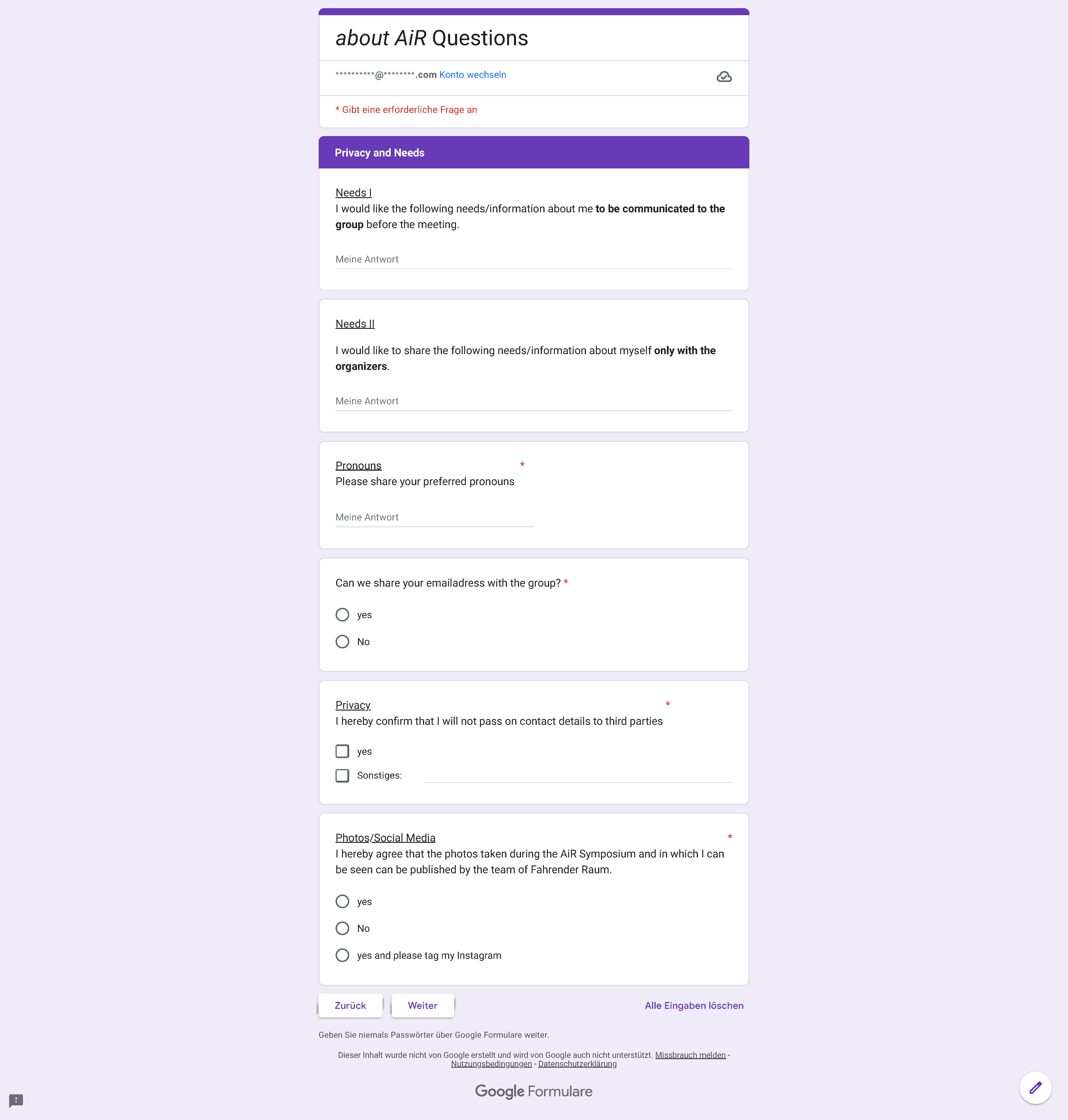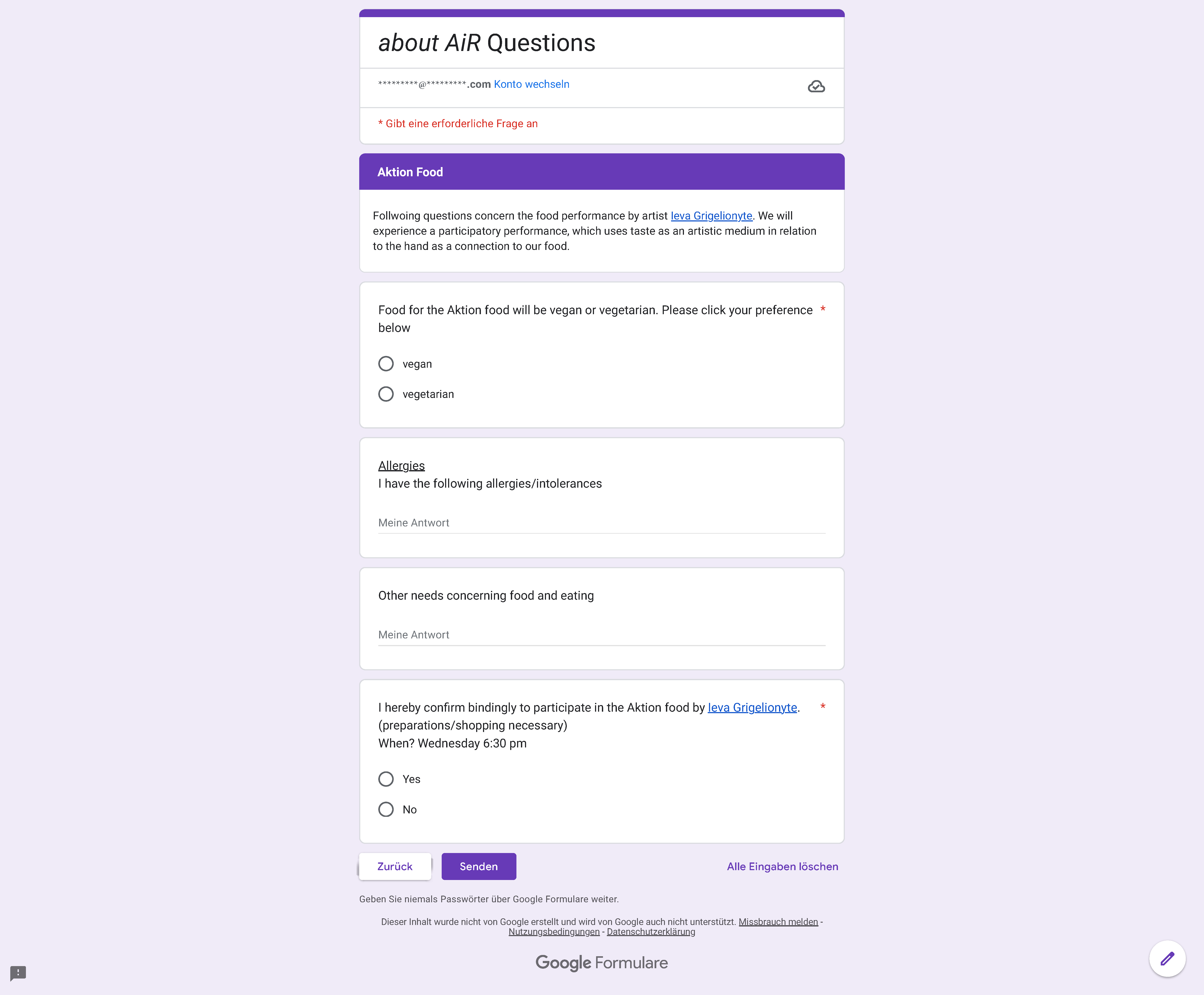
contact
Der Fahrende Raum
info@fahrender-raum.de
links
Linksammlung
how to AiR (Checklists)
HOW TO AiR?
here is a checklist that residency organizers and residency participants can use for planning their Artist-in-Residency program.
This checklist is the outcome of "about AiR", where we discussed following questions:
what is an art pedagogical residency?
what is the difference between classic AiR and art pedagogy AiR?
how could a perfect AiR look like?
HOW TO AiR?
guidelines are impossible to write, because of different settings of different AiR programes - that's why we decided to summarize our discussions and thoughts as a question catalog / checklist.
-
-
- GENERAL CONDITIONS / FRAMEWORK
- invitation letter / open call
- commission / jury
decision: prioritize good artistic work or good pedagogue?
portfolios are sent to the institution > the children look over the portfolios and choose the AiR - quota (classism, sexism/genderism, racism, ableism, homophobia, lookism, ageism/adultism, other -isms etc.)
- contract
- guideline for communication
- access rider (hyperlink)
- What is the structure and how can the structure be communicated between artist, inviter and audience?
- what are your must-haves?
- Are there AiR programs for early carrier artists other than Erasmus?
- is there a protection concept (safe*r space*s)?
Who is inviting, who is invited, who participates in the social practice/community based project (classism, sexism/genderism, racism, ableism, homophobia, lookism, ageism/adultism, other -isms etc.) - How can Feedback take place for both sides?
How can Feedbackforms look like? (Bulletpoints, multiple choice+other) Can this be made public?
Maybe on website of the inviter? Is there a fee that includes working time that artist needs for writing feedback?
Can there be e.g. a kind of “rating website” in form of an evaluation for AiR programs?
What are the criteria?
It must be very detailed: Can there be a feedbackform that is very detailed? Can this be combined with the feedbackforms described in the question earlier? (Take care: neoliberal approach?) - How are funding structures? How has funding to be justifies (critical documentation)? What is “critical documentation”?
- Can an organizer/artist/participant communicate insecurities and failures to the public or the funder and how?
- How to change structures inside of institutions to take responsibility for the institutional worker? Who is the institution? Is there a safety structure for wrong decisions?
- How to create transparency (about funding, fees, working conditions ...)
- How to avoid emotional stress?
- Arts vs. art pedagogy/mediation.
Hybrid?
Is it arts, is it art pedagogy, is it pedagogy, is it social work at the same time (this is the case for Der Fahrende Raum)? All in one? Transdisciplinary?
What happens if those fields become a hybrid?
Is the artist a pedagogue?
does the artist have experience in working with children or in mediation?
Does the artist like to work with children in the frame of a social practice? does the artist see their social practice as their artistic work? > bring not a concept but bring a research together WITH children - pedagogical / mediative turn in curatorial studies tries to solve the hierarchy between artistic practice and art pedagogical practice
- inform yourself about the different forms of social practice
- Social Practice : Participatory art - Socially engaged art - Community art
- Community-Based Practice: Community - driven practice - Collaborative practice - Grassroots practice
- Social-Based Arts: Socially responsive arts - Civic arts - Public art
- GENERAL CONDITIONS / FRAMEWORK
-
-
-
-
- What about authorship in community based practice?
- Are there existing residencies that work with the hybrid: arts and pedagogy/social practice (e.g. Der Fahrende Raum (Germany), Bilding (Austria)). Can we create a network between thoses existing residencies and share expereinces and skills.
Note: We are happy to receive your e-mails about other projects or programs that work in this hybrid situation >>> info@fahrender-raum.de - Can there be a link archive? What are the categories? (Crip time, Glossar Carmen Mörsch)
- What about residencies in Museums?
- What about practicality? How can a utopian idea be put into practice?
- Are workshop participants payed within a community based/social practice? Suggestion: Free-Choice-Fee-Distribution: Within a heterogeneous group there are participants with different economic backgrounds. Freelancers, for example, may have lost work opportunities as a result of their participation, while others may have a permanent job and may even come as part of their salary. Some of us will inherit, some of us will not. Some own property or have savings, others do not. Some have family support, others do not.
Free-Choice-Fee-Distribution means: there is a fixed amount of money that the participants are entitled to as compensation. For example, one thousand euros for ten participants. The participants can then decide anonymously whether or not they want to accept the fee. Let us assume that two of the ten participants decide to accept the payment and the rest decide against it. Thus, the two participants who are in a more difficult financial situation than the others will each receive an allowance of five hundred euros. This amount will also be divided among the needier participants. They remain anonymous within the group.
-
-
HAVE YOU THOUGHT ABOUT ... ?
(some aspects from above will occur again)
ASPECTS OF AiR PROGRAMS
-
- room and space for different needs
- care (for the artist, for the inviter, special needs)
- hierarchies (inviter, invitee)
- childcare (for artist-parents and their children)
- purpose, goal, intention, framework (agreement/fair contract)
- code of conduct
- access rider (needs, wishes, boundaries)
- insurance
- assistance (artistic or social)
- accommodation (where? winter:cold, summer:hot? Alone or with partner/child/pet/accompaniment? Consider: some people cannot/might not want to stay alone.)
- working space (workshop?)
- working tools/material
- space (for workshops, social practice, etc)
- food (daily allowance)
- time (is the artist forced to work directly, or can they first arrive and get an idea about the place/city/institution? Purposeless time? Free time? Joy?)
> is AiR a job? - expectations (hidden expectations lead to tension →comminicationstyle; time for research and thinking or directly working; are there set working hours or can the artist choose when and how much to work: e.g. DFR has program opening hours to which the artist has to commit)
- continuity
- a minimum of structure
- fee/money
- host (is there experience with AiR programs? Is there a contact person? What is the contact person ́s role? Emotional care/physical care?)
- accessability
- temporary communities (Is the artist getting introduced to the local art scene? Introduction to local environment/pedagogical networks; possibility for friendships?)
- connections (Is the artist getting connected with other local art institutions?)
- audience (Does the inviter guarantee/choose/invite an audience or does the artist need to find the audience themselve? Is the workshop a closed committed group or does the drop-in-drop-out principle apply? Who is the audience?)
- the unexpected: risk and surprise (Do you accept it and how do you handle it?)
- professional atmosphere or friendship hangout?
- critical documentation (how does that look like. Problem: for funding we have to document the good stuff, what about documenting what went wrong and how to communicate it?)
- possibility to change
- complaint structures (feedback etc.)
- authorship in community based practices (is it a portfolio work or a process based work without the expectation of an outcome?)
- credit and acknowledgements
- space to show works / exhibition
- visibility: online presence (Is social media/website presence wanted and needed?)
- visibilty: advertising (Flyer, handouts etc.)
this list is fluid, if you want to complete or feedback on the list, please write an e-mail to info@fahrender-raum.de
starting point
Tanja Hamester & Sophia Köhler
starting point of About AiR
thank you for coming not to the mountain but to the FatCat
thank you for your time

"Once upon a time there was an unsuccessful project application to the Munich Department of Culture.
Imagine - us sitting on a mountain in Chiemgau now.
The sun goes down, the trees are blowing in the wind.
Spring is coming. Allergy is coming.
...
A residency program about residencies (Sophia: woooooow)
...
But, no…
The Munich Department of Culture:
Hybrid?
Meta-layers?
“This program is not eligible to be funded.”
“Five days is not a residency”
...
So, what is a residency?
These and many other questions we will be discussing over the next few days."
WELCOME TO ABOUT AiR
it is a conference, a symposium, art educational artist residency (AiR = Artist in Residence program), working group, tea time, congress and excursion, a compromise, Apéro, …a place to learn and unlearn
and we will talk and think about the following Questions:
How can the role and artistic work of resident artists be thought of and implemented in terms of art mediation/education?
What might an inclusively designed open call for an art mediation/education residency program look like?
How can various demands, expectations, and needs of all program participants be communicated? And many more.
Before we start, we want to set up a structure and talk about the frame of this meeting:
everybody's free to leave the room, whenever they want to toilet is across the hall.
FEEDBACK & CRITIQUE
We very much welcome your feedback and critique.
You find a box where you can leave feedback in a written form.
We are happy if you share strategies with us. Feedback and critique is a way to learn and unlearn.
At the end of the day we will held feedbackrounds, too.
PRIVACY
we will tell each other insider experciences: if there are details or stories I want to share but I don't want them to become public you can tell the group. With the disclaimer “I don´t want this information to become public” other participants agree on keeping the information. The protocol writer will not write down such information in the protocol. Especially when it comes to names of people who are not present. Lets try to handle this mindfully
The precondition for participating in this meeting is to accept this confidentiality agreement and the protection of private matters. If there is anyone who cannot or does not want to comply with this, we kindly ask them to leave.
PROTECTION CONCEPT / PROPOSAL FOR THE CONFERENCE
we would like to create a “safe*r space” during the three days
we know that this is a hard thing to achieve
we ask you to not ask people about their use of medical aids and health conditions
There can always be situations that might trigger you or make you feel uncomfortable, there might even happen unforeseen discriminations or acts and speech of carelessness (doesn't matter whether intended or not)
therefore we propose:
1. S and T are your contact persons
Example: Someone keeps mispronouncing your pronouns. >You can tell us in private and we can make sure the person is reminded to mindfully use their language. So you don´t have to directly address it.
We are of course happy if the whole group takes over a certain care commitment. Means, you are aware of things happening: talk to the person. But please, lets not be intrusive. We trust you with this.
2. Time Out Code Word : “Bear on the rooftop”
This code word interrupts the program. All group members come together.
When is the Code Word used?: Discussions and problems that you can't deal with on your own, that you are overwhelmed with, that make you feel so uncomfortable that you need to address them right away, someone gets hurt, someone is in danger etc.
As we are organizing this event, we have of course the responsibility to mediate difficult situations. But there might be situations that Sophia and I are not able to mediate or there might be issues that you, the participants, don't want to have mediated by us.
We want to offer “Bear on the rooftop” as a moment when the whole group takes on the issue. In this way, the clarification and responsibility does not rest on one person (who maybe has a certain hierarchy or power position), but the responsibility for clarification is handed over to the whole group. We will then try to find a solution together.
MODERATION & PROTOCOLS & TIMEKEEPING & SPEAKING TIME
before we go through our conference program with you in detail we would like to talk about the set-up concerning protocols, timekeeping and moderation.
obviously T and S are moderating right now
For the rest of the time we two would function as moderators even during the different inputs to kind of guide you through the parts of the conference
Therefore, we would like to hand over the writing of the protocols to some of you.
Here is a laptop where you can type the protocol in. protocols are like diaries/reminder/written down memory/documentation.
The form of the protocol can vary - depends on what slot you are writing about. They are helping us to remember what happened and to give an impression of the conference for people who weren’t there. This is an important aspect because we weren’t able to invite everyone to this conference. Plus to create a public.
The next part that we would like to hand over to you is the keeping of time.
This means you have an eye on the clock and announce to the group certain time stamps / how much time is left.
We want to take care of the proportion of everyone's speaking time. The timekeeper raises a table tennis racket so as not to actively interrupt anyone, to remind the person speaking to watch their speaking time.
PROGRAM & PROTAGONISTS
please see the other pop-up windows on this website (program under AKTIONEN and protagonists under PROTAGONISTS)
WHAT IS DER FAHRENDE RAUM?
please check out this website: Der Fahrende Raum
PERFECT ARTIST IN RESIDENCE PROGRAM
we asked the question: what is a perfect AiR ? how would it look like? what does it need?
there is no such thing as a perfect AiR.
but we collected aspects and open questions for you to get an idea of it - you can read them in the pop up window called HOW TO AiR.



protagonists
International and Munich-based artists and art educators were involved in About AiR.
1. Alicia Fackler - student visual arts and art education, Colophon Magazine
2. Angela Stiegler - visual artist, art educator (e.g. at Museum Lenbachhaus), Website
3. Annabell Lachner - visual artist (sculpting) and art educator from Munich, Website
4. Chalo Schwaiger - student visual arts and art education at AdbK, Website
5. Clara Laila Abid Alsstar - visual artist, art educator, Website
6. Flavia Tritto - visual artist and curator VOGA art project, VOGA
7. Franziska Lütke - visual artist and art educator with art teaching experience at public schools
8. Ieva Grigelionyte - visual artist, Website
9. Jemina Inkeri Vainikka Lindholm - visual artist, cultural producer, art educator, community pedagogue and museum worker living and working in Helsinki, Finland, Website
10. Julia Richter - , fashion designer and art educator at art space Lothringer 13 Halle Munich, Lothringer13
11. Mako Sangmongkhon - visual artist, art educator, PhD candidate in anti-discriminatory art pedagogics, Website
12. Mona Feyrer - visual artist and direction art pedagogy at Museum Lenbachhaus Munich, Lenbachhaus
13. Sarah John - student visual arts and art education at AdbK, Project
14. Sophia Köhler - visual artist, art educator, artistic direction of Der Fahrende Raum (2022-2024), Website
15. Susanne Beck - visual artist, art educator at art space Lothringer 13 Halle Munich, Lothringer13
16. Tanja Hamester - visual artist, art educator, artistic co-worker of Der Fahrende Raum, Website
17. Uli Ball - visual artist, art teacher, art educator at Museum Pinakothek der Moderne, Website
18. Vera Brosch - student of visual art and art education is our co-worker for about AiR, Project
Here are some impressions of the three days.


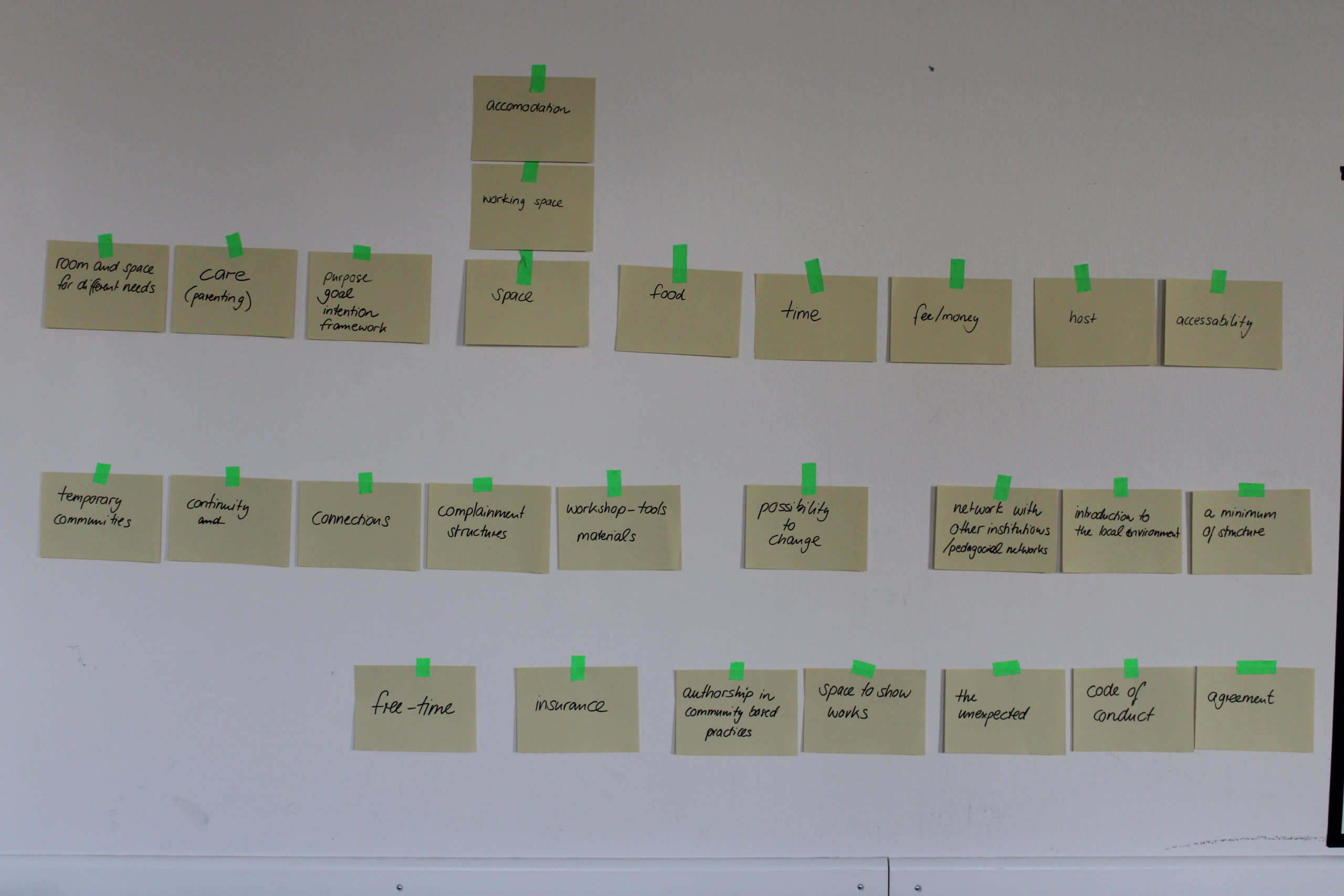





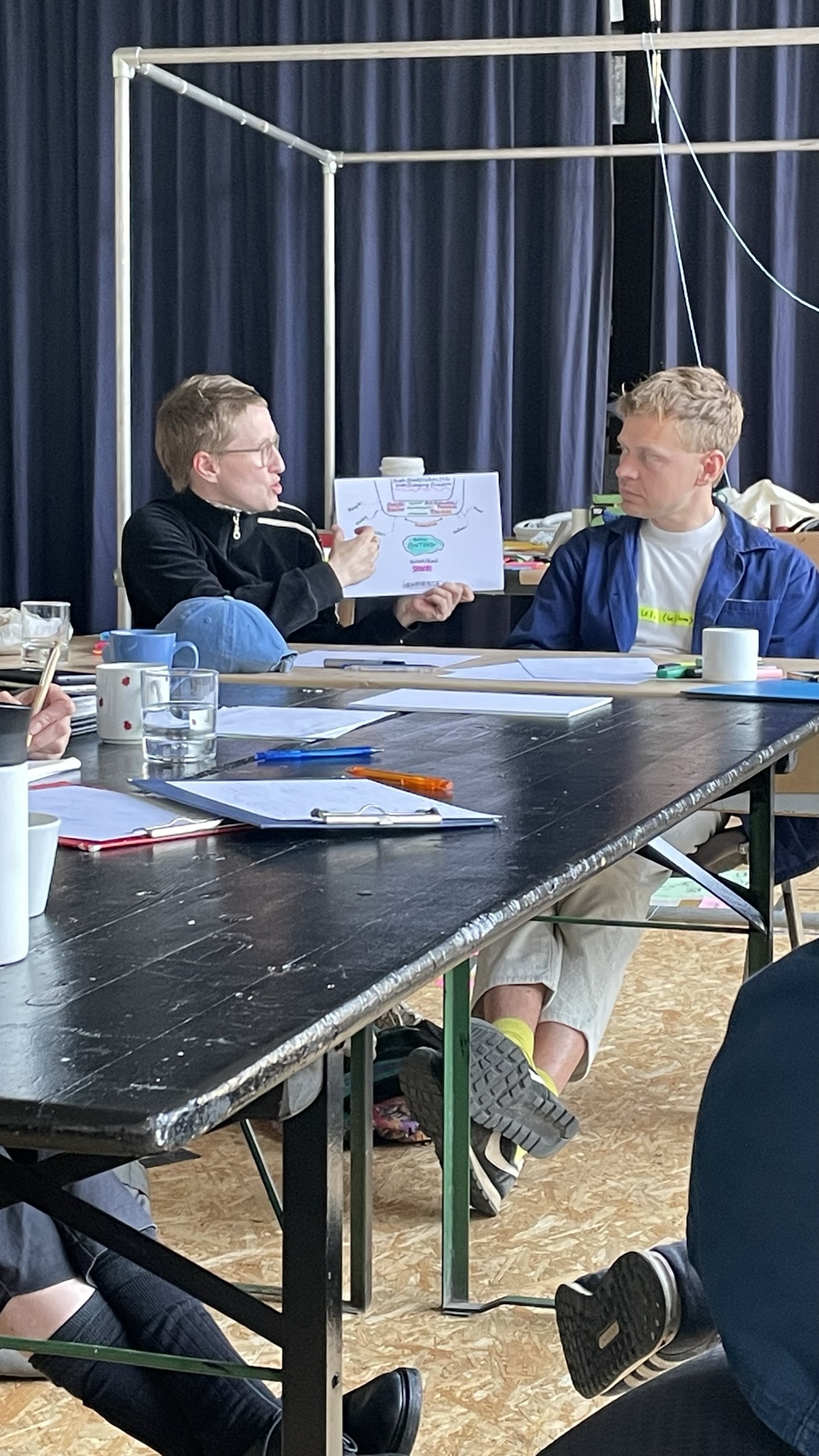

keys
Chalo Schweiger & Alicia Fackler
KEYS

KEYS was an Aktion about getting to know each other.
You carry a certain amount of keys with you every day.
Maybe on a key chain.
You take out your keys.
You choose the three most important keys.
You tell the group what the key is for and what that means for you and others.
Keys are linked to rooms and spaces.
A key means you have access to a room.
A key means you have responsibility for a room.
A key means you have power over a room.
A key means protection inside a room.
is there a room that you don't have the key for?
imagine this room.
what does that room look like?
what can you do inside the room?
where is the room?
does the room already exist?
is the room fictional?
would you like to share your key?
with whom would you like to share your key with?
are there people in the group that have a similar idea / vision of that room?
find those people and work on a model of that vision.
you have completed your models of the rooms.
where are they positioned in the actual room?
why are they positioned there?
how would you connect them to each other?
In their AKTION, Alicia Fackler & Chalo Schweiger applied various strategies for getting to know each other. An exchange about the keys that we all carry with us every day led to a artistic examination of sometimes imaginary spaces to which we wish to gain access. Together, we created models of imaginary spaces that took all of our needs into account and linked them together.
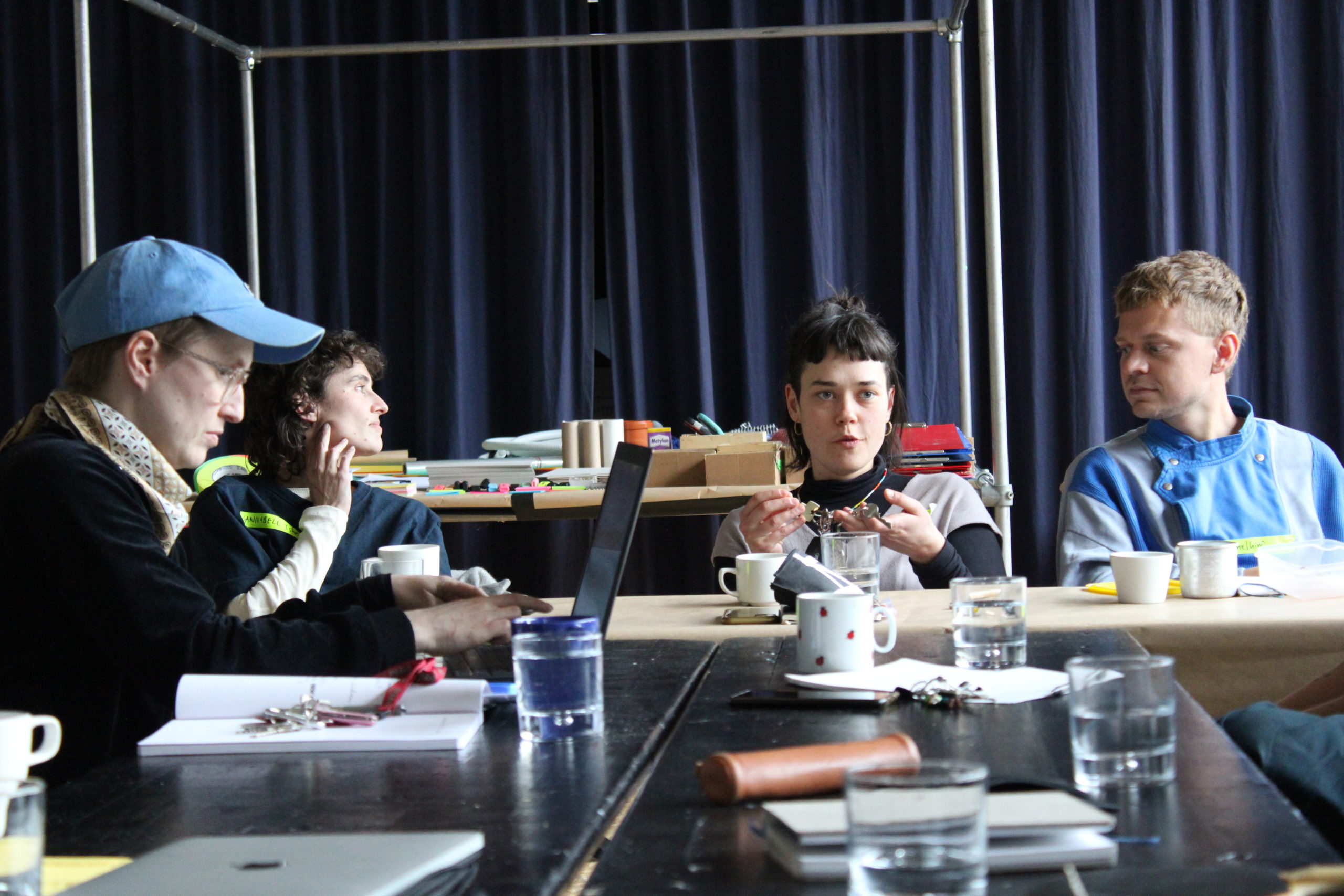







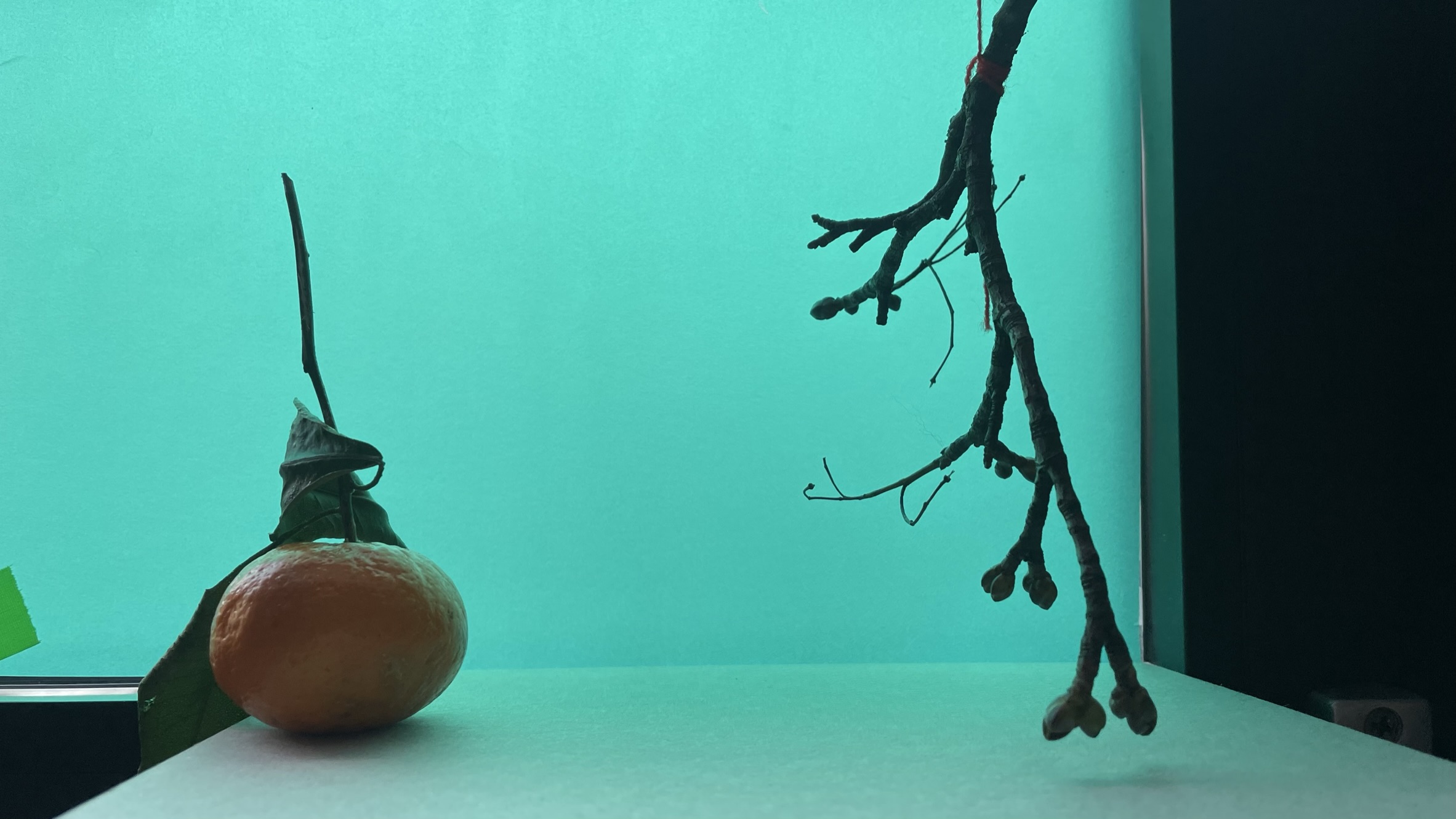








acknowledge
Clara Laila Abid Alsstar & Mako Sangmongkhon
Acknowledge
you arrive at this place through breathing.
you write down three key words that are floating in the collective think space.
we collect the key words on the floor.
you select three key words out of the collection.
you take these three words with you.
now you write automatically using these words.
after a certain amount of time we gather again.
if you feel like it, you can share your writing with the group.
you write down the beginning of a sentence.
we mix all of those sentence fragments.
you take one of those fragments with you.
now you write automatically starting with the fragment.
after a certain amount of time we gather again.
if you feel like it, you can share your writing with the group.
Clara Laila Abid Alsstar & Mako Sangmongkhon offered writing practices with the Aktion “Acknowledge”. In order to create an extended offer to the group discussion methodology, terms from the previous day's discussions were jointly selected as starting points and raised to a poetically abstract level in the form of “writing as artistic practice”. This enabled new perspectives and points of view on questions about art education residencies and the associated content.
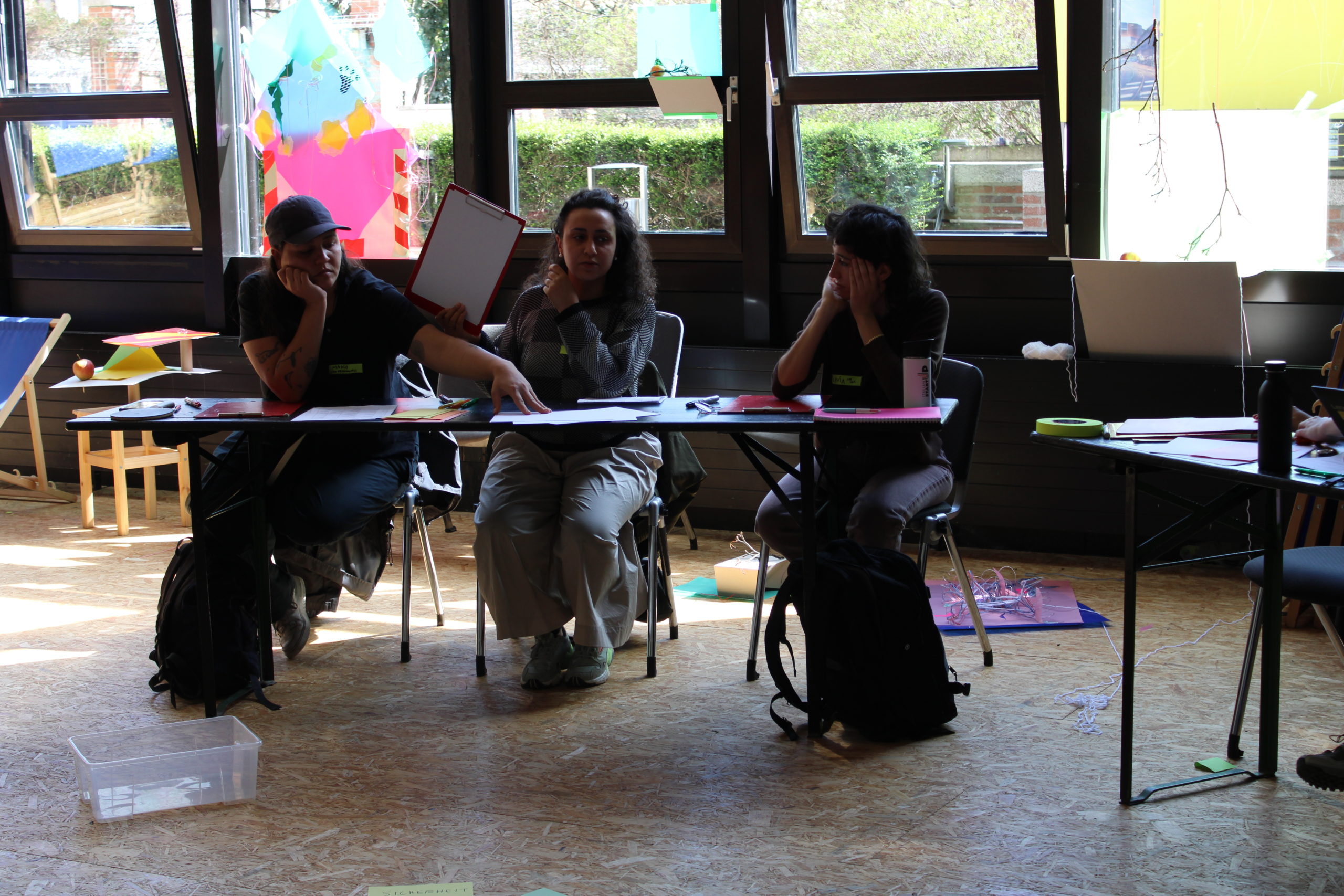

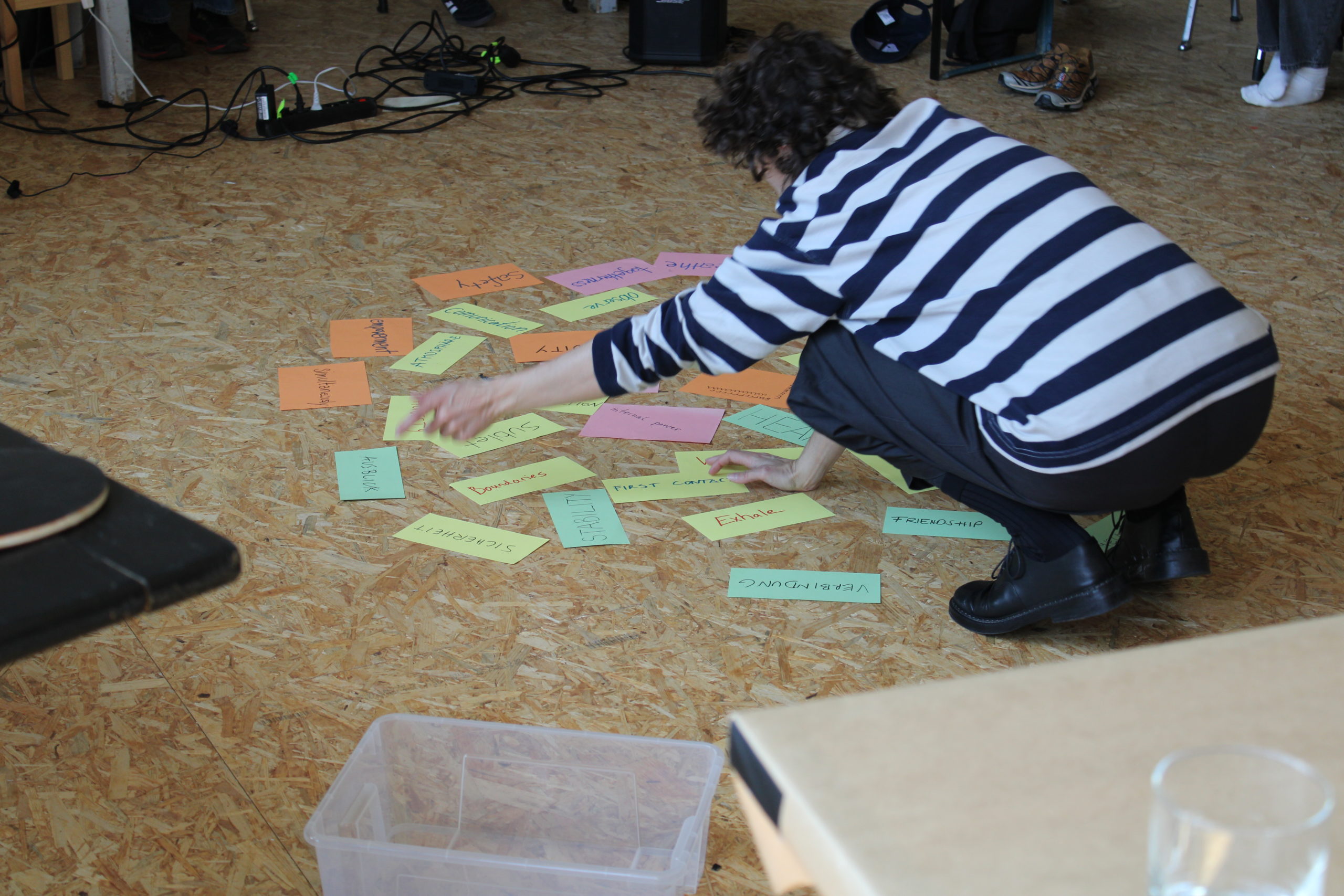
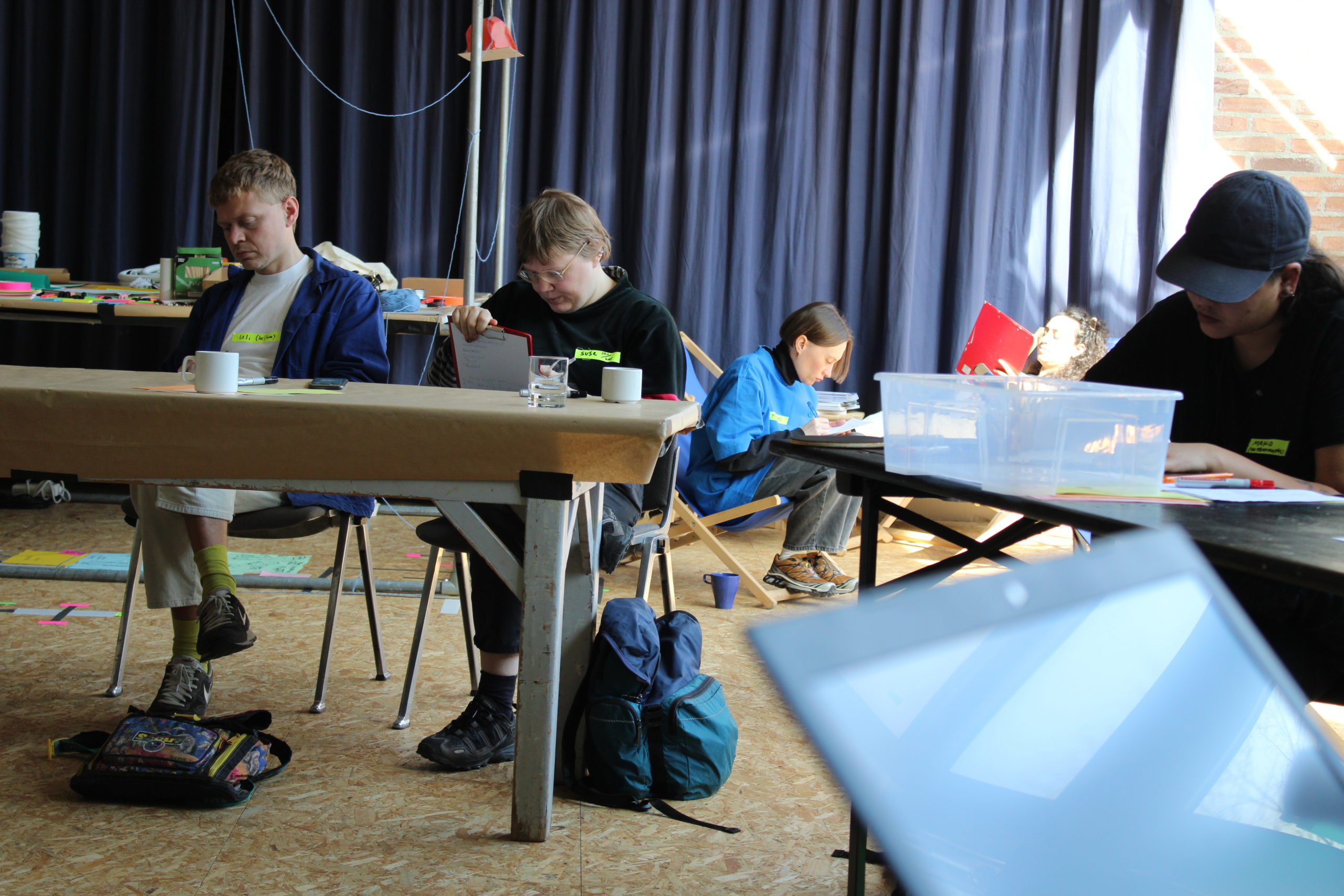
access riders - Jemina Lindhom
Jemina Inkeri Vainikka Lindholm
Access Riders
NEEDS WISHES BOUNDARIES
needs (Things I absolutely must have in order for this to work for me.),
wishes/wants (Things I’d like to happen.)
and limits/boundaries (What I’d prefer to have present for this to be a comfortable, positive experience for me)
A personalised Access Rider gives you the opportunity to provide individual information about your own needs, wishes and boundaries. This document can be updated at any time if required. An Access Rider can be completed by all participants and does not have to be solely focussed on physical impairments. Use this document to let us know your individual accessibility requirements.
“An access rider is a document written by an
individual, and can be shared when one is invited
to take part in a project or any working
relationship. It can work as a starting point for a
conversation between the inviter and invitee about
the accessibility of a certain situation.”
– Jessie Bullivant & Jemina Vainikka Lindholm: Access Riders, 2021“The dictionary definition of consent
is ‘permission for something to happen or agreement
to do something’. What I’m asking here is what
conditions make it most likely that those involved
can give their agreement for something to happen.
In order to be able to do this they must be able
to:
1. Tune into how they feel: what they need and
want, where their limits and boundaries are.
2. Communicate about this with the others involved,
knowing that they are free-enough,safe-enough,
and able to be honest, and that their position
will be heard and respected.”
– Meg-John Barker: The Consent Checklist”Needs and limits are the things we absolutely must
have - and not have - in order for it to work for
us. Wants are the things we’d like to happen,
and boundaries express what we’d prefer to have
present - or not - for it to be a comfortable,
positive experience for us.”
– Meg-John Barker: The Consent Checklist
These quotes were part of Jemina's key note during the aktion.
Learn more about Jemina's work: Jemina Inkeri Vainikka Lindholm
Jemina Inkeri Vainikka Lindholms Aktion dealt with the Access Rider, a personalised document that gives you the opportunity to provide individual information about your own needs, wishes and boundaries. This document can be updated at any time if required. An Access Rider can be completed by all participants and does not have to be solely focussed on physical impairments. It is a tool for communication between the artist and the institution. Vainikka Lindholm gave insights about crip theory, the various aspects of Access Rider and their impact.


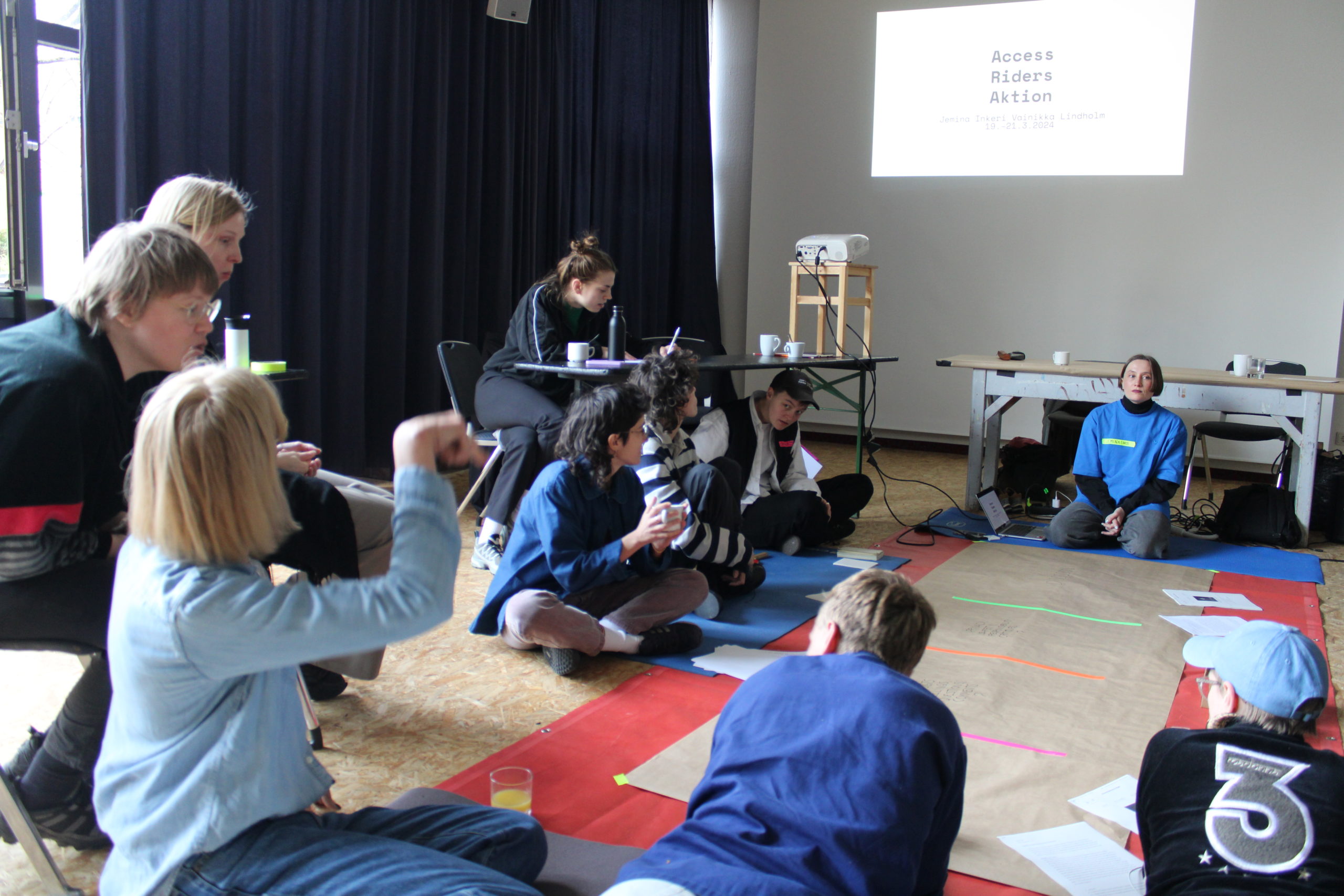

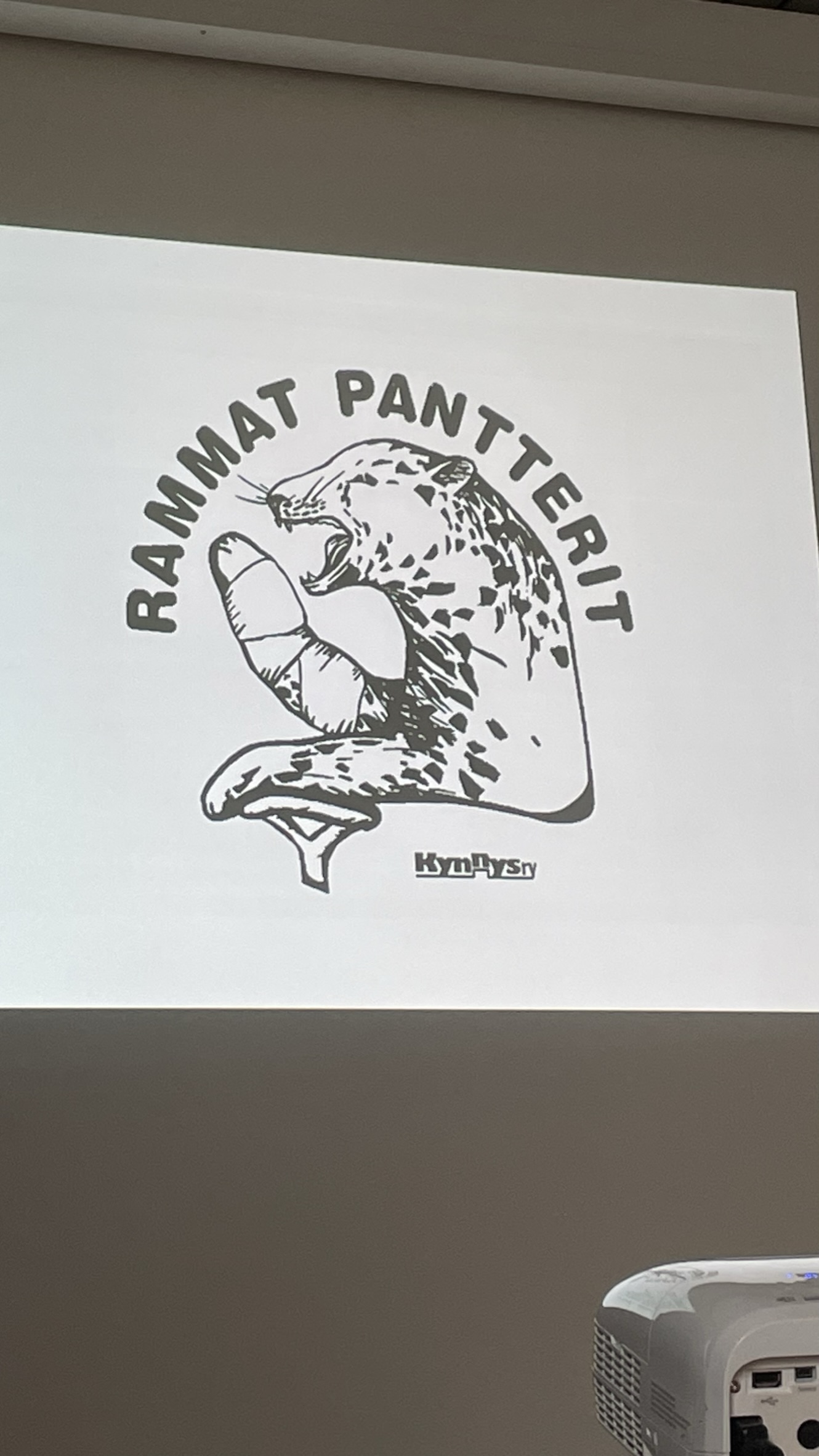
Links for more examples of Access Riders:
[DE]
https://diversity-arts-culture.berlin/magazin/access-rider
[EN]
https://diversity-arts-culture.berlin/en/magazin/access-rider
examples of Access Riders
https://frame-finland.fi/wp-content/uploads/2021/04/access-riders_WEB.pdf
a landscape
Ieva Grigelionyte
A landscape carried with you:
hills of knuckles, valley of palm, and fingertip forests
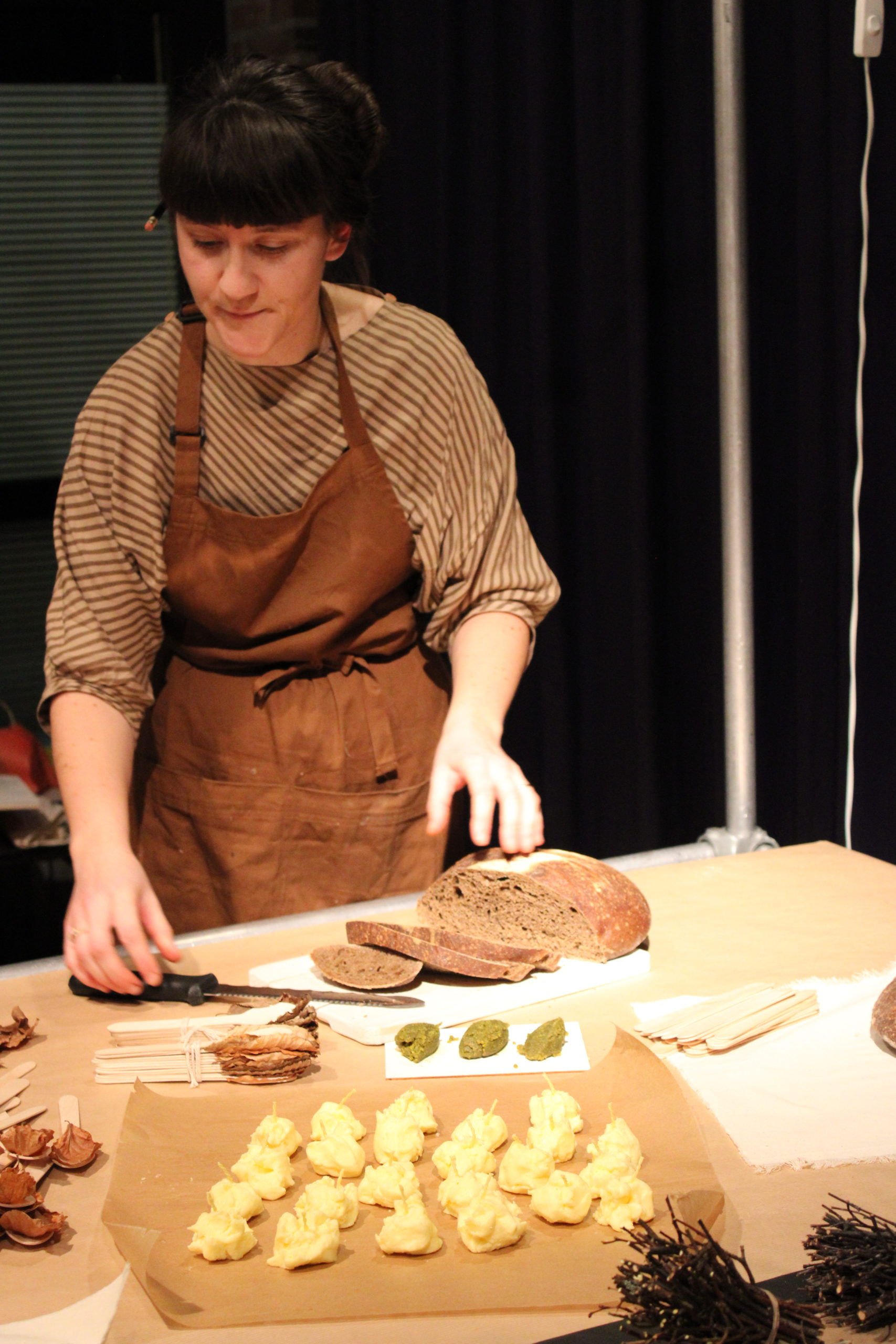
Ieva Grigelionyte offered a multisensory exploration of the unique role our hands play in shaping our interaction with the world. Grigelionyte’s wish was to illuminate the hand more than a mere tool; it is a personal landscape, an intimate medium that navigates and interacts with our surroundings. Through this exploration, the project invited participants to reconsider the hand's significance not only in anticipating taste but in constructing and enriching our culinary narratives, urging us to view them as the intimate landscapes they truly are, forever carried with us.
Ieva Grigelionyte's Aktion points to the question of whether the basic needs of all (like food) should not receive the same attention as theoretical work. For this reason, Grigelionyte designed a public, site-specific dinner at which about AiR participants and externals could engage in exchange and conversation while eating, tasting, seeing, smelling and touching together. Grigelionyte was thus not only a nourisher, but also transferred the entire process of preparing and eating food together into the spectrum of artistic production.



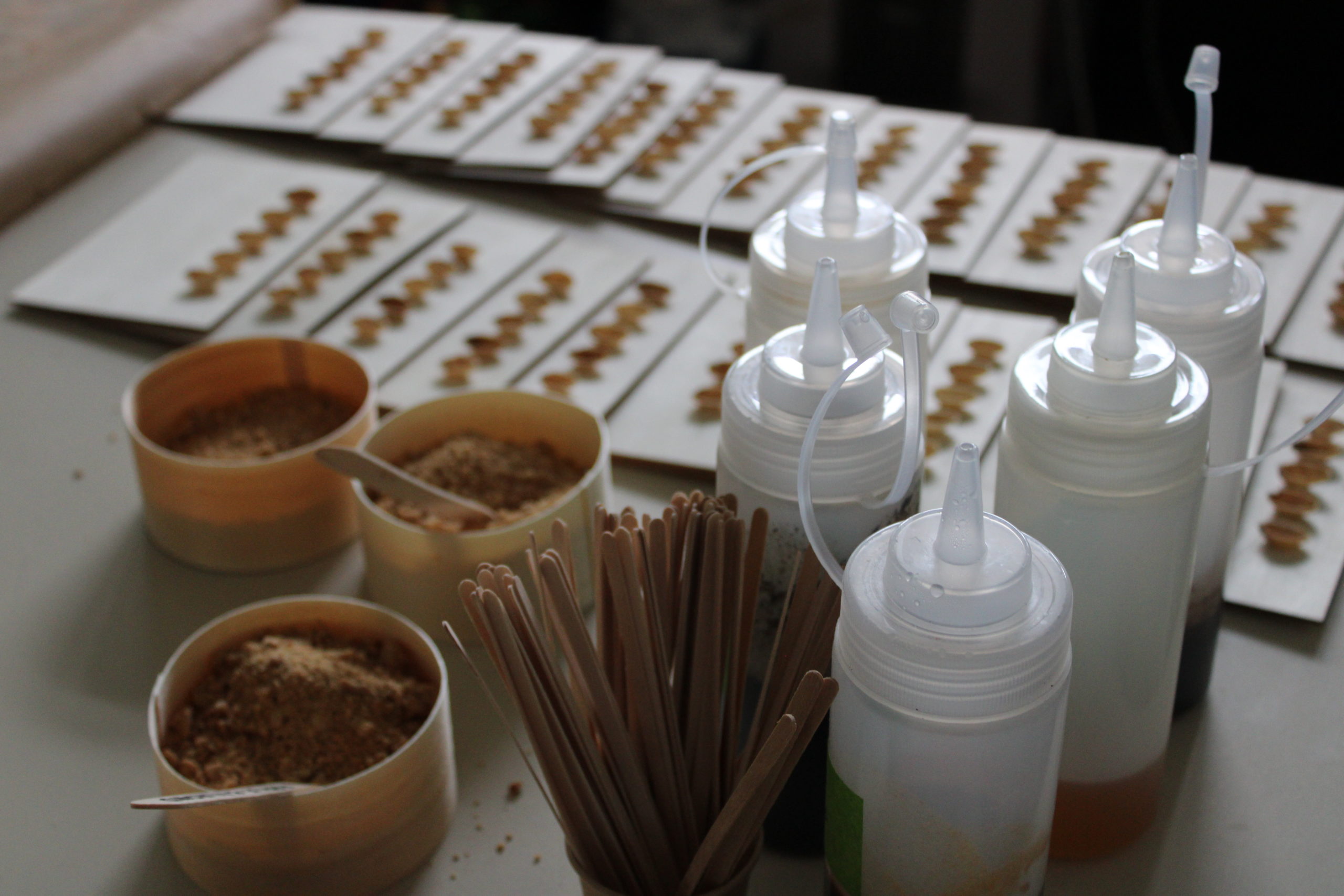











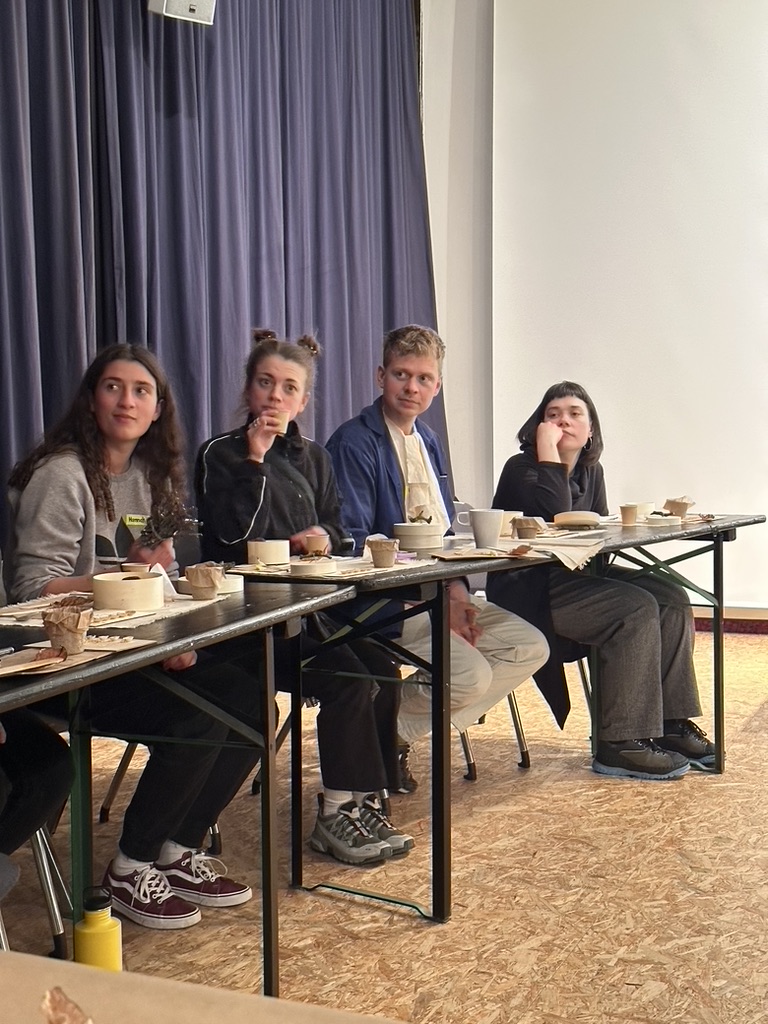






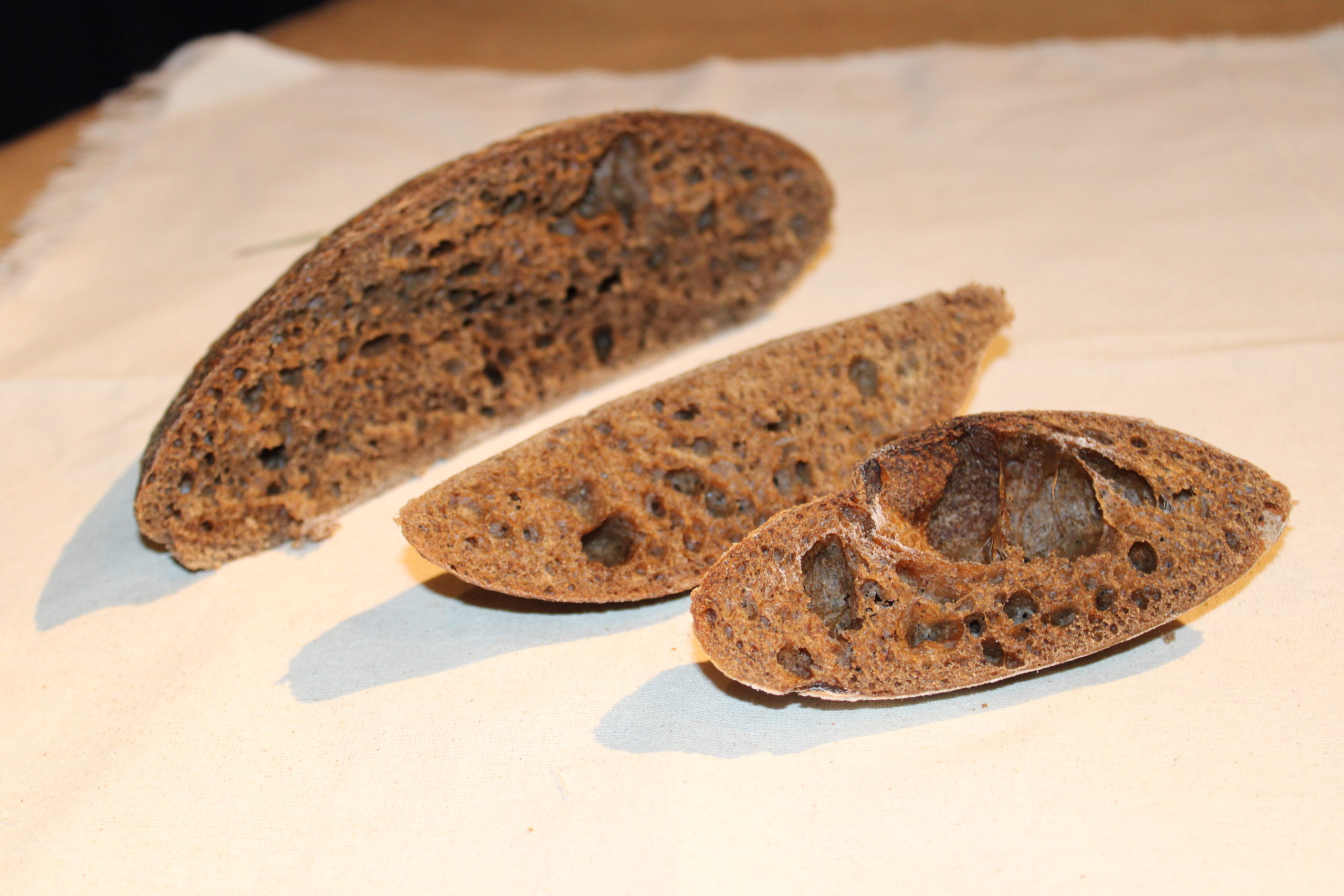
about air

this website is a documentation of the hybrid ABOUT AiR (conference, symposium, residency, gathering).
this website is collected data and material from ABOUT AiR.
this website can be used as open source (for organizing a residency program, for doing a residency, for organizing a conference, for your own interest, ...)
In the process of updating the project Der Fahrende Raum in 2024, the need emerged to take a closer look at art pedagogical residency programs. In our previous research, we have found that while most residency programs, including the Residency of Der Fahrende Raum, contain a mediating aim, there are hardly any residencies that explicitly focus on the aspect of mediation and pedagogy. This was the reason to invite experts and protagonists for joint thinking and transnational exchange.
about AiR is a three-day gathering of Munich-based and international protagonists in the field of visual arts, art education and art pedagogy, focusing on questions related to art mediation and art education residency programs.
about AiR sees itself as a hybrid of a symposium, art educational artist residency (AiR = Artist in Residence program), working group, conference, congress and excursion.
about AiR arises from the residency experience of Der Fahrende Raum and the necessity to develop methods for transnational residency programs that integrate art pedagogy with local children and young adults within the artistic project.
Objective
The project aims, with a transnational team, to think about strategies for art educational and art mediation residencies.
This is made available to a wider audience through this website. We hereby transfer the analog thinking space into a digital one, laying the groundwork for collaborative and public work in the spirit of Open Source.
At the beginning of the process the following questions will be addressed:
How can the role and artistic work of resident artists be thought of and implemented in terms of art mediation/education?
What might an inclusively designed open call for an art mediation/education residency program look like?
How can various demands, expectations, and needs of all program participants be communicated?
Project Location and Dates
about AiR took place at FatCat in Munich (former Gasteig), a cultural center near the river Isar.
Twenty protagonists took part in the discussions and Aktionen from Tuesday 19.03.2024 to Thursday 21.03.2024.
The setting we provided differed from a traditional symposium setting. Additionally, a conceptual constellation arises: the residency symposium itself becomes a residency. The invited participants are simultaneously experts on residencies and residents themselves.
Participants and Schedule
To ensure a heterogeneous and transnational composition, we invited the following participants: artists, curators, students, residency organizers, arts and culture practitioners, art educators, and researchers.
All invitees and participants were considered residents. Unlike a traditional symposium, there were mediative and participative Aktionen instead of lectures. This means all protagonists were not just passive listeners but engaged in discussion rounds, workshop situations, and working groups.
Guidelines and Handbook
The project aims, with a hybrid team, to create an expanded handbook (practical guidelines and artistic contributions from the symposium) for art educational and art mediation residencies.
This will be made available to a wider audience through an interactive and participatory website (documentation of the gathering, handbook with comment function, linking of network actors). We hereby transfer the analog thinking space into a digital one, laying the groundwork for collaborative and public work on the handbook in the spirit of Open Source.
Together, we are developing a publicly accessible handbook for contemporary conceptualization and implementation of an art mediation/education AiR program, usable globally in institutions like Fahrender Raum or others. It forms a knowledge and strategy pool accessible to everyone.
Access Rider
via google forms we created an access rider that we sent to the participating protagonists before the conference.
here you can download it:
ABOUT AiR ACCESS RIDER

